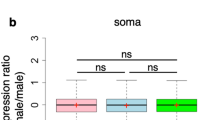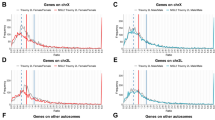Abstract
Polycomb genes in Drosophila maintain the repressed state of homeotic and other developmentally regulated genes1,2,3,4 by mediating changes in higher-order chromatin structure5,6,7. M33, a mouse homologue of Polycomb, was isolated by means of the structural similarity of its chromodomain8. The fifth exon of M33 contains a region of homology shared by Drosophila and Xenopus8,9. In Drosophila, its deletion results in the loss of Polycomb function10. Here we have disrupted M33 in mice by inserting a poly(A) capture-type neor targeting vector into its fifth exon. More than half of the resultant M33cterm/M33cterm mutant mice died before weaning, and survivors showed male-to-female sex reversal. Formation of genital ridges was retarded in both XX and XY M33cterm/M33cterm embryos. Gonadal growth defects appeared near the time of expression of the Y-chromosome-specific Sry gene11, suggesting that M33 deficiency may cause sex reversal by interfering with steps upstream of Sry. M33cterm/M33cterm mice may be a valuable model in which to test opposing views regarding sex determination.
This is a preview of subscription content, access via your institution
Access options
Subscribe to this journal
Receive 51 print issues and online access
$199.00 per year
only $3.90 per issue
Buy this article
- Purchase on Springer Link
- Instant access to full article PDF
Prices may be subject to local taxes which are calculated during checkout




Similar content being viewed by others
References
Lewis, E. B. Agene complex controlling segmentation in Drosophila. Nature 276, 565–570 (1978).
Wedeen, C., Harding, K. & Levine, M. Spatial regulation of Antennapedia and Bithorax gene expression by the Polycomb locus in Drosophila. Cell 44, 739–748 (1986).
Beachy, P. A., Helfand, S. L. & Hogness, D. S. Segmental distribution of bithorax complex proteins during Drosophila development. Nature 313, 545–551 (1985).
Kuziora, M. A. & McGinnis, W. Different transcripts of the Drosophila Abd-B gene correlate with distinct genetic sub-functions. EMBO J. 7, 3233–3244 (1988).
Paro, R. & Hogness, D. S. The Polycomb protein shares a homologous domain with a heterochromatin-associated protein of Drosophila. Proc. Natl Acad. Sci. USA 88, 263–267 (1991).
Zink, B. & Paro, R. In vivo binding pattern of a trans-regulator of homeotic genes in Drosophila melanogaster. Nature 337, 468–471 (1989).
Orlando, V. & Paro, R. Mapping Polycomb-repressed domains in the Bithorax complex using in vivo formaldehyde cross-linked chromatin. Cell 75, 1187–1198 (1993).
Pearce, J. J. H., Singh, P. B. & Gaunt, S. J. The mouse has a Polycomb-like chromobox gene. Development 114, 921–929 (1992).
Reijnen, M. J. et al. Polycomb and bmi-1 homologs are expressed in overlapping patterns in Xenopus embryos and are able to interact with each other. Mech. Dev. 53, 35–46 (1995).
Müller, J. Transcriptional silencing by the Polycomb protein in Drosophila embryos. EMBO J. 14, 1209–1220 (1995).
Hacker, A., Capel, B., Goodfellow, P. & Lovell-Badge, R. Expression of Sry, the mouse sex determining gene. Development 121, 1603–1614 (1995).
Gubbay, J. et al. Agene mapping to the sex-determining region of the mouse Y chromosome is a member of a novel family of embryonically expressed genes. Nature 346, 245–250 (1990).
Eicher, E. M., Washburn, L. L., Whitney, J. B. II & Morrow, K. E. Mus poschiavinus Y chromosome in the C57BL/6J murine genome causes sex reversal. Science 217, 535–537 (1982).
Eicher, E. M. & Washburn, L. L. Inherited sex reversal in mice: identification of a new primary sex-determining gene. J. Exp. Zool. 228, 297–304 (1983).
Nagamine, C. M. et al. The musculus-type Y chromosome of the laboratory mouse is of Asian origin. Mamm. Genome 3, 84–91 (1992).
Luo, X., Ikeda, Y. & Parker, K. L. Acell-specific nuclear receptor is essential for adrenal and gonadal development and sexual differentiation. Cell 77, 481–490 (1994).
Wagner, T. et al. Autosomal sex reversal and campomelic dysplasia are caused by mutations in and around the SRY-related gene SOX9. Cell 79, 1111–1120 (1994).
Foster, J. W. et al. Campomelic dysplasia and autosomal sex reversal caused by mutations in an SRY-related gene. Nature 372, 525–530 (1994).
Uchida, K. et al. Exclusion of Sox9 as a candidate for the mouse mutant Tail-short. Mamm. Genome 7, 481–485 (1996).
Coré, N. et al. Altered cellular proliferation and mesoderm patterning in Polycomb-M33-deficient mice. Development 124, 721–729 (1997).
Kessel, M., Balling, R. & Gruss, P. Variation of cervical vertebrae after expression of a Hox-1.1 transgene in mice. Cell 61, 301–308 (1990).
Takihara, Y. et al. Targeted disruption of the mouse homologue of the Drosophila polyhomeotic gene lead to altered anteroposterior patterning and neural crest defects. Development 124, 3673–3682 (1997).
van der Lugt, N. M. T. et al. Posterior transformation, neurological abnormalities, and severe hematopoietic defects in mice with a targeted deletion of the bmi-1 proto-oncogene. Genes Dev. 8, 757–769 (1994).
Akasaka, T. et al. Arole for mel-18, a Polycomb group-related vertebrate gene, during the anteroposterior specification of the axial skeleton. Development 122, 1513–1522 (1996).
Mittwoch, U. Sex differentiation in mammals and tempo of growth probabilities vs. switches. J. Theor. Biol. 137, 445–455 (1989).
Cattanach, B. M. Sex-reversed mice and sex determination. Ann. N. Y. Acad. Sci. 513, 27–39 (1987).
Burgoyne, P. S. & Palmer, S. J. The genetics of XY sex reversal in the mouse and other mammals. Semin. Dev. Biol. 2, 277–284 (1991).
Bunker, C. A. & Kingston, R. E. Transcription repression by Drosophila and Mammalian Polycomb group proteins in transfected mammalian cells. Mol. Cell. Biol. 14, 1721–1732 (1994).
Boer, P. H. et al. Polymorphisms in the coding and noncoding regions of murine Pgk-1 alleles. Biochem. Genet. 28, 299–308 (1990).
Robertson, E. J. in Teratocarcinomas and Embryonic Stem Cells: A Practical Approach (ed. Robertson, E.J.) 71–112 (IRL, Oxford, (1987)).
Acknowledgements
We thank T. Takeuchi, Y. Takihara, H. Koseki and T. Akasaka for advice and discussion; M. Djabali for communicating unpublished results; and R. A. Shiurba for critical reading of the manuscript.
Author information
Authors and Affiliations
Corresponding author
Rights and permissions
About this article
Cite this article
Katoh-Fukui, Y., Tsuchiya, R., Shiroishi, T. et al. Male-to-female sex reversal in M33 mutant mice. Nature 393, 688–692 (1998). https://doi.org/10.1038/31482
Received:
Accepted:
Issue Date:
DOI: https://doi.org/10.1038/31482
This article is cited by
-
Loss of cohesin regulator PDS5A reveals repressive role of Polycomb loops
Nature Communications (2023)
-
PRC1 suppresses a female gene regulatory network to ensure testicular differentiation
Cell Death & Disease (2023)
-
Context-specific Polycomb mechanisms in development
Nature Reviews Genetics (2022)
-
The roles of Polycomb repressive complexes in mammalian development and cancer
Nature Reviews Molecular Cell Biology (2021)
-
The CBX family of proteins in transcriptional repression and memory
Journal of Biosciences (2020)
Comments
By submitting a comment you agree to abide by our Terms and Community Guidelines. If you find something abusive or that does not comply with our terms or guidelines please flag it as inappropriate.



